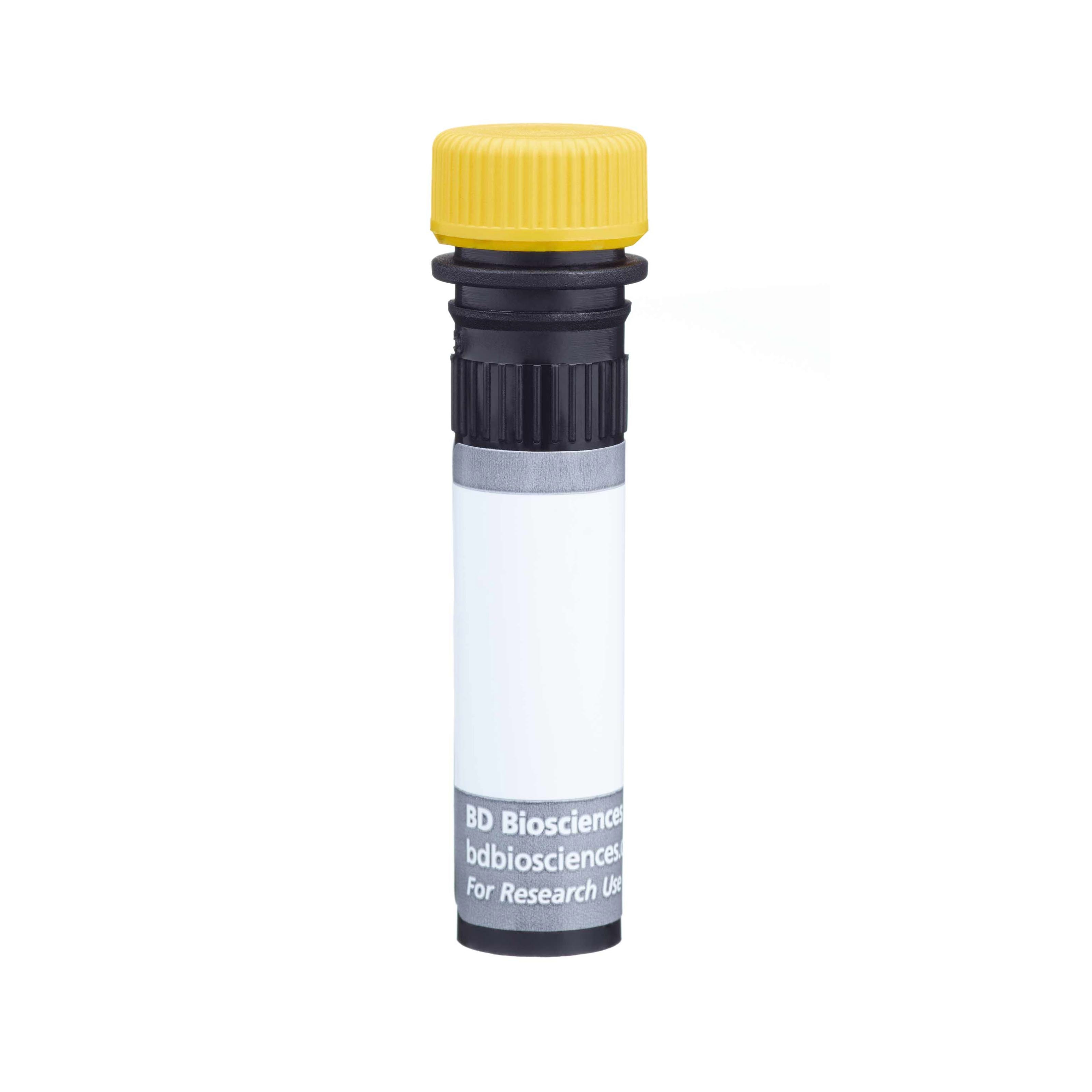Old Browser
Looks like you're visiting us from {countryName}.
Would you like to stay on the current country site or be switched to your country?
BD OptiBuild™ BUV661 Mouse Anti-Human Neuropilin-1 (CD304)
克隆 mAb3 (also known as MAB3; mAb#3)
(RUO)

监管状态图例
未经BD明确书面授权,严禁使用未经许可的任何商品。
准备和存储
推荐的实验流程
BD® CompBeads can be used as surrogates to assess fluorescence spillover (compensation). When fluorochrome conjugated antibodies are bound to BD® CompBeads, they have spectral properties very similar to cells. However, for some fluorochromes there can be small differences in spectral emissions compared to cells, resulting in spillover values that differ when compared to biological controls. It is strongly recommended that when using a reagent for the first time, users compare the spillover on cells and BD® CompBeads to ensure that BD® CompBeads are appropriate for your specific cellular application.
For optimal and reproducible results, BD Horizon Brilliant Stain Buffer should be used anytime BD Horizon Brilliant dyes are used in a multicolor flow cytometry panel. Fluorescent dye interactions may cause staining artifacts which may affect data interpretation. The BD Horizon Brilliant Stain Buffer was designed to minimize these interactions. When BD Horizon Brilliant Stain Buffer is used in in the multicolor panel, it should also be used in the corresponding compensation controls for all dyes to achieve the most accurate compensation. For the most accurate compensation, compensation controls created with either cells or beads should be exposed to BD Horizon Brilliant Stain Buffer for the same length of time as the corresponding multicolor panel. More information can be found in the Technical Data Sheet of the BD Horizon Brilliant Stain Buffer (Cat. No. 563794/566349) or the BD Horizon Brilliant Stain Buffer Plus (Cat. No. 566385).
Note: When using high concentrations of antibody, background binding of this dye to erythroid cell subsets (mature erythrocytes and precursors) has been observed. For researchers studying these cell populations, or in cases where light scatter gating does not adequately exclude these cells from the analysis, this background may be an important factor to consider when selecting reagents for panel(s).
商品通知
- Please refer to www.bdbiosciences.com/us/s/resources for technical protocols.
- Caution: Sodium azide yields highly toxic hydrazoic acid under acidic conditions. Dilute azide compounds in running water before discarding to avoid accumulation of potentially explosive deposits in plumbing.
- For fluorochrome spectra and suitable instrument settings, please refer to our Multicolor Flow Cytometry web page at www.bdbiosciences.com/colors.
- BD Horizon Brilliant Ultraviolet 661 is covered by one or more of the following US patents: 8,110,673; 8,158,444; 8,227,187; 8,575,303; 8,354,239.
- BD Horizon Brilliant Stain Buffer is covered by one or more of the following US patents: 8,110,673; 8,158,444; 8,575,303; 8,354,239.
- Please refer to http://regdocs.bd.com to access safety data sheets (SDS).
- Since applications vary, each investigator should titrate the reagent to obtain optimal results.
- Human donor specific background has been observed in relation to the presence of anti-polyethylene glycol (PEG) antibodies, developed as a result of certain vaccines containing PEG, including some COVID-19 vaccines. We recommend use of BD Horizon Brilliant™ Stain Buffer in your experiments to help mitigate potential background. For more information visit https://www.bdbiosciences.com/en-us/support/product-notices.
- Researchers should determine the optimal concentration of this reagent for their individual applications.
- The production process underwent stringent testing and validation to assure that it generates a high-quality conjugate with consistent performance and specific binding activity. However, verification testing has not been performed on all conjugate lots.
配套商品






The mAb3 monoclonal antibody specifically recognizes Neuropilin-1 (NRP1), also known as CD304, Blood dendritic cell antigen 4 (BDCA4), and Vascular endothelial cell growth factor 165 receptor (VEGF165R). Neuropilin-1 (CD304) is an ~140 kDa type I transmembrane glycoprotein that is encoded by NRP1 and expressed on plasmacytoid dendritic cells (DC), thymocytes, regulatory T cells, a subset of T follicular helper cells, endothelial cells, neurons, and certain tumor cells. This multifunctional receptor can mediate the interaction, growth, survival, and migration of a variety of normal and tumor cells including prostate and breast cancer cells. Neuropilin-1 (CD304) may play a role in the interactions between some T cells and dendritic cells. It is involved in the development of the nervous and cardiovascular systems. CD304 complexes with Plexin-A family members to bind chemorepellent Class 3 Semaphorins and guide neuronal axon growth. It also functions as a coreceptor with VEGFR2/CD309 to stimulate angiogenesis in response to VEGF165. It also functions as a co-receptor that can facilitate the entry of severe acute respiratory syndrome coronavirus 2 (SARS-CoV-2) into host cells.
研发参考 (7)
-
Bruder D et al. Neuropilin-1: a surface marker of regulatory T cells.. Eur J Immunol. 2004; 34(3):623-630. (Biology). 查看参考
-
Daly JL, Simonetti B, Klein K, et al. Neuropilin-1 is a host factor for SARS-CoV-2 infection. Science. 2020; 370(6518):861-865. (Immunogen). 查看参考
-
Dzionek A et al. BDCA-2, BDCA-3, and BDCA-4: three markers for distinct subsets of dendritic cells in human peripheral blood.. J Immunol. 2000; 165(11):6037-6046. (Biology). 查看参考
-
Mizui M, Kumanogoh A, Kikutani H. Immune semaphorins: novel features of neural guidance molecules.. J Clin Immunol. 2009; 29(1):1-11. (Biology). 查看参考
-
Pan Q et al. Neuropilin-1 binds to VEGF121 and regulates endothelial cell migration and sprouting.. J Biol Chem. 2007; 282(33):24049-24056. (Biology). 查看参考
-
Renand A, Milpied P, Rossignol J, et al. Neuropilin-1 expression characterizes T follicular helper (Tfh) cells activated during B cell differentiation in human secondary lymphoid organs.. PLoS ONE. 2013; 8(12):e85589. (Biology). 查看参考
-
Soker S, Takashima S, Miao HQ, Neufeld G, Klagsbrun M. Neuropilin-1 is expressed by endothelial and tumor cells as an isoform-specific receptor for vascular endothelial growth factor.. Cell. 1998; 92(6):735-45. (Biology). 查看参考
Please refer to Support Documents for Quality Certificates
Global - Refer to manufacturer's instructions for use and related User Manuals and Technical data sheets before using this products as described
Comparisons, where applicable, are made against older BD Technology, manual methods or are general performance claims. Comparisons are not made against non-BD technologies, unless otherwise noted.
For Research Use Only. Not for use in diagnostic or therapeutic procedures.